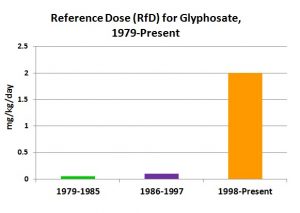Our paper entitled “Concerns over use of glyphosate-based herbicides and risks associated with exposures: a consensus statement” came out February 17, 2016 in the journal Environmental Health. It was written by John Peterson Myers, Michael N. Antoniou, Bruce Blumberg, Lynn Carroll, Theo Colborn, Lorne G. Everett, Michael Hansen, Philip J. Landrigan, Bruce P. Lanphear, Robin Mesnage, Laura N. Vandenberg, Frederick S. vom Saal, Wade V. Welshons and Charles M. Benbrook.
According to BioMed Central, publisher of Environmental Health, our glyphosate paper was the most heavily accessed and impactful review of 2016, as measured by its Altmetric score (695). As of June 3, 2017, there had been 29,996 accesses of the pdf of the paper.
Since our team did its basic research on the toxicology database and exposure assessments supporting contemporary uses of glyphosate herbicide (aka Roundup), many new papers and biomonitoring projects have reinforced the concerns raised in our 2016 paper.
 The EPA set the first chronic Reference Dose (called an ADI back then) for glyphosate at 0.05 mg/kg/day in 1979, the agency has increased it three times. As the chart to the left shows, it was first raised to 0.1 mg/kg/day, then to 1.0 mg/kg/day in 1982, then to 2.0 mg/kg/day by or around 1998.
The EPA set the first chronic Reference Dose (called an ADI back then) for glyphosate at 0.05 mg/kg/day in 1979, the agency has increased it three times. As the chart to the left shows, it was first raised to 0.1 mg/kg/day, then to 1.0 mg/kg/day in 1982, then to 2.0 mg/kg/day by or around 1998.
EPA took another action in 1994 that had the effect of more than doubling the cRfD. In March 1994, the Office of Pesticide Program’s Metabolism Committee reported in this memo their decision that residues of glyphosate’s primary metabolite, AMPA (aminomethylphosphonic acid), no longer needed to be included in the calculation of glyphosate residues in food.
Up until 1994, published tolerances for glyphosate covered the combined residues of glyphosate and AMPA. Dropping AMPA from inclusion in the calculation of glyphosate residues was comparable, roughly, to a doubling of the glyphosate cRfD.
Serious questions persist over the EPA’s justification for each of these increases (more to come soon on this topic). Had the EPA retained the first cRfD set for glyphosate (0.05 mg/kg/day), the explosion in glyphosate use beginning in the early 1990s would have triggered substantial dietary exposure concerns and the EPA would not have allowed the proliferation of high-residue, high-exposure pre-harvest crop desiccation use of glyphosate.

